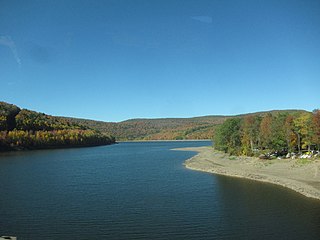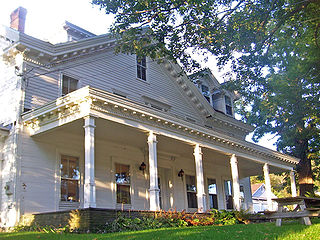
Margaretville is a village in Delaware County, New York, United States. The population was 596 at the 2010 census. The village is in the town of Middletown, on the border of the Catskill Park.
Andes is a town in Delaware County, New York, United States. The population was 1,114 at the 2020 census.

The East Branch Delaware River is one of two branches that form the Delaware River. It is approximately 75 mi (121 km) long, and flows through the U.S. state of New York. It winds through a mountainous area on the southwestern edge of Catskill Park in the Catskill Mountains for most of its course, before joining the West Branch along the northeast border of Pennsylvania with New York. Much of it is paralleled by State Route 30.

The Delaware and Hudson Railway (D&H) is a railroad that operates in the Northeastern United States. In 1991, after more than 150 years as an independent railroad, the D&H was purchased by the Canadian Pacific Railway (CP). CP operated D&H under its subsidiary Soo Line Corporation which also operates Soo Line Railroad.
The Ulster and Delaware Railroad (U&D) was a railroad located in the state of New York. It was often advertised as "The Only All-Rail Route to the Catskill Mountains." At its greatest extent, the U&D extended 107 miles (172 km) from Kingston Point on the Hudson River through the Catskill Mountains to its western terminus at Oneonta, passing through the counties of Ulster, Delaware, Schoharie and Otsego.
The Arkville station, MP 48.1 on the Ulster and Delaware Railroad (U&D), and MP 37.52 on the Delaware and Northern Railroad (D&N), was another busy station, as this served as a junction between the two railroads. This station bore a strong resemblance to the Grand Hotel station and the Pine Hill station, which both looked like longer versions of the Mount Pleasant station.

The Wallkill Valley Railroad is a defunct railroad which once operated in Ulster and Orange counties in upstate New York. Its corridor was from Kingston in the north to Montgomery in the south, with a leased extension to Campbell Hall. It crossed both the Wallkill River and Rondout Creek.

Halcottville station, MP 53.0 on the Ulster and Delaware Railroad (U&D), served the hamlet of Halcottville. On February 1, 1932, the U&D became the Catskill Mountain Branch of the New York Central Railroad. In addition to the station, the U&D constructed a large ice-house here and stored ice from Lake Wawaka. A tiny steamboat, also named Wawaka, plied the lake during the summer months drawing visitors from up and down the line who rode the boat and picnicked on the shores of Lake Wawaka. Halcottville boasted a hotel, two creameries, an early electric light plant, several stores, a post office, dance hall, school, and several churches. There were also numerous boarding houses in the area.
Grand Gorge station, MP 65.5 on the Ulster and Delaware Railroad (U&D), originally known as Moresville, is a train station that had more freight service than passenger service. Its main business was the freight coming from the local farms and dairy products from the Decker-Slawson Creamery, which later became the Sheffield Farms Creamery. It also served the nearby community of Prattsville.

New York State Route 30 (NY 30) is a state highway in the central part of New York in the United States. It extends for 300.71 miles (483.95 km) from an interchange with NY 17 in the Southern Tier to the US–Canada border in the state's North Country, where it continues into Quebec as Route 138. On a regional level, the route serves to connect the Catskill Park to the Adirondack Park. In the latter, NY 30 is known as the Adirondack Trail. Aside from the state parks, the route serves the city of Amsterdam and several villages.

The Pepacton Reservoir, also known as the Downsville Reservoir, is a reservoir in Delaware County, New York on the East Branch of the Delaware River in the Catskill Mountains of New York. Part of the New York City water supply system, it was formed by the construction of Downsville Dam, and impounds over one-quarter of the East Branch's flow.

Ferrocarril Central Andino (FCCA) is the consortium which operates the Ferrovías Central railway in Peru linking the Pacific port of Callao and the capital Lima with Huancayo and Cerro de Pasco. As one of the Trans-Andean Railways it is the second highest in the world constructed by the Polish engineer Ernest Malinowski in 1871–1876.
The Delaware and Ulster Railroad (DURR) is a heritage railroad based in Arkville, New York.

The Ulster & Delaware Railroad Historical Society is a chapter of the National Railway Historical Society (NRHS). It focuses on the history of the railroads and related social, economic, and cultural institutions of the Catskill and Hudson Valley regions. That history, which began with the charter of the Catskill & Ithaca Railroad in 1828, encompasses numerous proposed and built railroads and trolley lines within Ulster, Delaware, Greene, Schoharie, Albany and Otsego counties.
Downsville is a hamlet, census-designated place (CDP), and former village in the town of Colchester, Delaware County, New York, United States. The population was 617 at the 2010 census.

The Galli-Curci Theatre is located on Main Street in Margaretville, New York, United States. It is a brick building erected in the 1920s, now primarily used as a store, although some of the original theater remains. It was named after opera singer Amelita Galli-Curci, who summered at her historic country estate near Margaretville from 1922-1937 and sang at its opening night.

Arkville is a hamlet in the Town of Middletown, Delaware County, New York, United States. It is located along New York State Route 28, one mile north of the village of Margaretville in the western Catskill Mountains. It has the ZIP code 12406.

Halcottsville is a hamlet in the town of Middletown, Delaware County, New York, United States, on the south shore of Wawaka Lake. It was named for John Halcott (1758-1831), a Revolutionary War soldier from Delaware County. He resided with his son Thomas in Halcottsville until his demise. Halcottsville is located on the East Branch Delaware River and New York State Route 30 5.6 miles (9.0 km) northeast of Margaretville. Halcottsville has a post office with ZIP code 12438. The hamlet has a stop on the excursion Delaware & Ulster Railroad which originates in nearby Arkville and extends north to the village of Roxbury.













